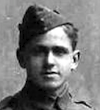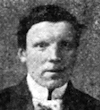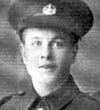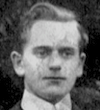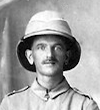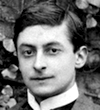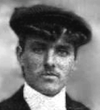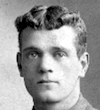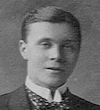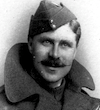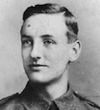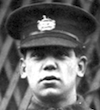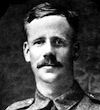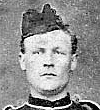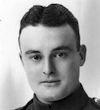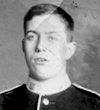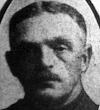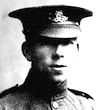Moulsham War Memorial: First World War
The following are the men whose deaths in the First World War are commemorated.on Moulsham War Memorial, situated in front of
St. John’s Church in Moulsham Street, Chelmsford.
Click on the man’s name to go to a webpage showing what is known about him.
As photographs of the men are discovered they will be added below and on the man’s individual webpage.
Many of these men also appear on the Chelmsford Civic Centre War Memorial - those marked with an * are not listed there.
Below are the names of men omitted from the memorial at St. John’s Church, Moulsham who have good cases for inclusion:
Frederick ATTRIDGE Jackson BACON* Eric Fothergill BAINBRIDGE* Arthur Albert BAKER William Redman BONESS* Percy Charles BUTCHER
William CAMPBELL Norman Thomas CLARKSON Richard Thomas COLE William CROW Henry James CRUMPEN* Sydney William DAY
Cecil Edward DORMAN Ernest Edward ELLIS Harry David ELLIS Arthur William EMSDEN Robert Walter FINCH* Sidney Hindmarsh FROST
Frederick Stanley GOSLING Edmond John HADDOCK William Charles HOCKLEY* Frederick Charles HOOKER Charles Wilfred JEFFREYS
William James LANCASTER Alfred Henry MOTT* Cecil Wilfred NEAVE John Arthur ROBERTS Arthur SALTMARSH Colin George SMITH*
Leonard Mark SMITH Bennett Richard STUBBINGS Ernest Harry SUCKLING George Charles SURRIDGE Ernest Cyril TAYLOR
Frederick Gerald THOMPSON Frederick William THORNE Sidney William TINSLEY Charles Henry TUNSTALL
The First World War Memorial to the men of the parish of Moulsham who lost their lives in that conflict was unveiled at St. John's Church in Moulsham Street on Sunday 7th November 1920.
The memorial, designed by Mr. Wykeham Chancellor, took the form a handsome cross erected midway between the entrance gates of St. John's Church and the main church door. The cross was of Portland some, standing on an hexagonal plinth, on four sides of which were inscribed the names of the fallen. Over them were the words: "In memory of the men of Moulsham who fell the Great War, 1914-1919." The cost of the memorial, raised by voluntary subscription, amounted to over £200.
The memorial was the first of a public nature to be erected within the Borough of Chelmsford and so the unveiling ceremony was attended by a very large number of people. There was also a crowded congregation in the church, where an impressive service was conducted by the Vicar, the Rev. R. F. Burnett, who wore his uniform as hon. chaplain to the Forces. The singing was led by some members of Crompton's Silver Band, under Mr. A. Higby. Mr. H. A. Parker (the organist) accompanied the band on the harmonium.
The service was attended by the Mayor (Cr. J. G. Dixon, J.P.) and members of the Corporation in state. The civic body was met at the church door by the Vicar and choir, the procession being headed by the cross bearer, Corpl. L. Symonds (K.R.R.C. Cadets and the processional banner carried by Pte. Gooch (also of the Cadets). Special seating provision was made for the relatives and friends of the fallen.
The hymns, "Give us the wings faith to rise," and "Now the labourer's task is over," were sung, and the 23rd psalm was chanted.
The Rev. G. C. Twist (curate) read the lesson. The Vicar encouraged the congregation to "remember with thanksgiving and with honour before God and men, those from this parish who have given their lives in the service of their King and country," and there was an impressive silence for a few moments, the congregation kneeling.
After prayers Canon Lake dedicated the clergy stall, the brass tablet bearing the inscription: "Presented by Ambrose and Alice Darby in memory of their sons killed in the Great War—Stanley Edward, 1915; Harold Edgar, 1916. Also Harry Arthur, accidentally drowned 4th August, 1903."
As the processional hymn, "On the Resurrection morning," was being sung, the clergy and choir, followed by members of the Corporation, proceeded to the memorial outside for the unveiling ceremony. Apart from the gathering inside the church gates, there were lined up the roadway
representatives of the ex-Service men organisations carrying their banners; Boy Scouts from the majority the troops in the Chelmsford and District Association, under District Scoutmaster A. Merritt; about 60 members the 5th Essex Regt., under Major G. Wilkes and Capt. and Adjt. Paxton; and boys of the K.R.R.C. Cadets.
The procession outside the church was led by the Hoffmann Brass and Reed Band, under Mr. George Lee. The Cadets' Bugle Band was also present.
The unveiling ceremony was performed by Sir S. W. Hare, K.C.M.G.. C.B., commanding the 54th (East Anglian) Division. General Hare said that the object of such memorials was to preserve the memory of those who fell in that great fight for the right, and also be constant reminder to all of the great lesson of duty and self-sacrifice which these men had taught.
He looked upon these brave fellows as a great example—as men who had taught and would continue to teach a great lesson of duty and self-sacrifice, and who through danger and hardship attained a high standard of Christian virtue, which might never have been developed by them had they not called upon to face dangers and hardships.
The General then released the cord fastening the Union Jack around the cross, and the Vicar offered dedicatory prayers.
During the singing of the hymn, "For all the saints," the procession reformed and returned the church.
Canon Lake, in an appropriate address, said if they were to have the victory of peace as well as of war, there must be the spirit sacrifice.
In the months after the unveiling additional names were added to the memorial as those 'missed' came to light.
Despite being made of Portland Stone the memorial has been badly eroded over the years, and so in 2013, on the eve of the centenary of the start of the war only a few of the names carved in the stone were decipherable. No 'official' list of those named on the memorial appears to have survived. However, a transcription of the names appeared in a 1921 Street Directory and that, together with the work of the Essex Society for Family History, who in 1994 transcribed as best they could the names still visible then, and my own research has produced a list of 109 names that are linked to this webpage.
It may be that by the time the memorial reaches its centenary it will have been restored so that the names of the fallen can continue to be read as first intended. In May 2014 the memorial was cleaned by Chelmsford City Council,

